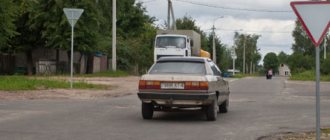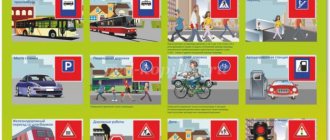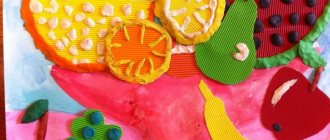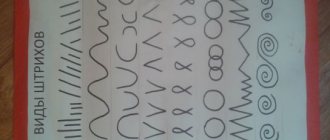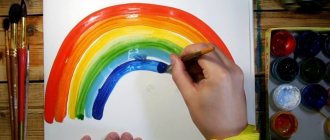Summary of a drawing lesson on traffic rules in the middle group 2015 – March 4, 2015
Arouse parents' interest and desire to attend family holidays.
Show children and their parents knowledge of traffic rules.
Create a friendly environment and positive relationships between parents and children.
Progress of the game:
Educator: – Dear friends! We are pleased to welcome you to our family living room. Thank you everyone for wanting to make friends with us. Today, when every now and then you see gloomy, worried faces, it is nice to see people with a kind, friendly smile and a happy look. And if it’s a family, then it’s doubly nice! We are pleased to introduce you to these families: So, let’s meet! Family No. 1, Family No. 2, Family No. 3, Family No. 4, Family No. 5, Family No. 6
Educator: Today the theme of our family holiday is: “Know and follow the rules of the road.” In our age of enormous speeds, there are many cars on the roads, all kinds of accidents and traffic incidents. This topic is the most relevant today. We are for order and safety on the roads! Before our eyes, family competitions for THE BRAVE, MOST REVENUE AND PRACTICAL will be played out.
And since we have competitions, it means there must be a strict and fair jury.
So, I represent our jury: the head of the kindergarten Dudnik S.N., the teacher of the younger group Ignatenko L.N., a member of the parent committee, we are starting our competitions
Competition No. 1: “Crossroads of Riddles” Children participants are invited to guess riddles on a road theme, and their parents help them. Anyone who knows quickly answers:
A striped horse, they call it a “zebra”, but not the one in the zoo, people still walk along it. – TRANSITION
I blink my eyes tirelessly day and night and I help cars and I want to help you. - TRAFFIC LIGHT
The house goes down the street, everyone is driven to work not on thin chicken legs, but in rubber boots. - BUS
Not alive, but walking, not mobile, but leading. - ROAD
He's lucky, not a horse, he's wearing galoshes, he looks at the red and immediately stands up himself. - AUTOMOBILE
It rides on two wheels, doesn’t slip on slopes and there’s no gas in the tank, it’s mine – BICYCLE
Competition No. 2: “Road Patrol” Parents are asked tricky questions, and children help them answer:
What insect sitting in the grass is the same color as the traffic light? - GRASSHOPPER
Where to wait for public transport? – STOP
Who is the owner of the crossroads? - TRAFFIC LIGHT
In which fairy tale and which character has a hat the same color as the traffic light? - LITTLE RED RIDING HOOD
What part of the road is for cars? – DRIVING
What is the name of the person who regulates traffic on the road? – REGULATOR
What color of the traffic light signal is missing in the poem “My Merry Tinkling Ball”? – GREEN
What is the name of the person who rides on the bus? – PASSENGER
What is the name of the traffic controller's stick? – ROD
At what age can you ride a bicycle? – FROM 14 YEARS OLD
JURY SCORE
Well, we’ve worked hard, it’s time to relax with our family.
Competition No. 3: “Musical Family.” Each family must perform a song, the words of which are somehow related to road traffic and transport.
Competition No. 4: “Smart guys and smart girls.” You need to think carefully and guess the make of the car from the first letters of the pictures.
Competition No. 5: “Guess it.” This is the most difficult, but very interesting competition. The family must put together a picture and name the type of transport.
JURY ASSESSMENT.
Head: – I would like to thank the participants in our competition “Know and Follow the Rules of the Road”, and say thank you to the families who supported our participants in the hall. Dear participants of our competition, you showed what friendly, close-knit families you have, ready to help each other, that’s why friendship won in our competition today. In memory of our meeting, you are awarded medals for the bravest, most resourceful and most practical
yavderevne.ucoz.ru
Artistic and aesthetic development. Drawing. Topic: “I am a pedestrian.” (middle group)
Artistic and aesthetic development. Drawing.
Topic:
“I am a pedestrian.”
Educational areas covered:
Cognitive development. Speech development. Social and communicative development. Artistic and aesthetic development
Activities:
cognitive - research, play, communication.
Target:
speech development of middle preschool children with special needs development
Objectives:
Correctional and educational
:
- develop the ability to create an image of a person in a drawing;
- continue to introduce the main parts of the body and their functions (head and neck, arms and legs are attached to the body and can move).
- develop the ability to draw large, in accordance with the size of a sheet of paper;
- continue to develop the ability to draw individual objects
Correctional and developmental:
- develop in children a sense of rhythm, composition, and cultivate aesthetic feelings;
- consolidate the skills of painting a limited surface.
Correctional and educational:
- create conditions for stimulating creative imagination, memory, accumulation of positive emotional experience;
- to cultivate friendly relationships in children when analyzing work, to develop such qualities as responsiveness and empathy.
Material:
sheets of white paper, sets of geometric shapes in envelopes, simple and colored pencils; traffic light image.
Progress of continuous educational activities:
- Motivational - organizational stage:
Joint greeting (psycho-gymnastics):
Let's hold hands together
And we will feel the warmth.
Let's turn around and smile -
Like our sunshine.
- Main part.
- Guys, today we will continue our conversation about traffic rules.
— What are the rules of the road? (these are rules that all road users must follow).
— Today we will walk around the city. Imagine that we left the kindergarten on the street
and went on foot. (Children move around the group.)
—
What can we be called as road users? That's right, pedestrians.
—Who are “pedestrians”?
—Where can I cross the street? (On transitions.)
— What should you do before crossing the street? (Look to the left, then walk to the middle of the road and look to the right, and then walk the rest of the distance.)
— Why can’t you cross the street at a red traffic light? (Because cars move very fast. You can fall and the driver will not have time to brake.)
2.2.
Outdoor game with speech accompaniment “Cheerful Pedestrian”.
Children stand in a circle at some distance from each other and turn to face the center of the circle.
A cheerful pedestrian is walking in a circle. (walk in place, vigorously wave their arms)
He walks through the streets and sings cheerfully: (clap hands)
“I will follow the traffic rules without objection.” (“spring”, hands on the belt)
I will listen to the traffic light instructions without arguing. (bend forward, arms move back and up).
I will go forward only where there is a transition. (walk in place, hands down)
Caution - red color! (place one hand with a shelf in front of the chest; the elbow of the second hand is on the back surface of the palm of the first hand, swing the second hand perpendicular to it from side to side)
This means there is no way for me!
Yellow - be careful! (squat, arms forward, palms down)
When it's green, go ahead! (raises hands on belt)
The passage has become clear (they walk in place, hands to shoulders)
I move forward boldly. (clench and unclench their fists.)
One, two - left! (they walk in place, vigorously waving their arms)
Free transition!
One, two - left! (clap hands)
I am a cheerful pedestrian!” (raise their hands up).
2.3. Demonstration of the teacher and joint work with children.
Go to your desks.
- Today, I propose to draw pedestrians walking along the street.
— The geometric shapes that lie on your tables will help us with this.
-What figures do you see? (circle, rectangles).
— Are all rectangles the same? What is the difference? (One is long and wide, the others are short and narrow)
- Did you know that if you add up all these figures in a certain order, you can get an image of a human figure?
- The upper part of the body is the head (lay out a circle)
- The head is on the neck. The neck is movable, so the head can tilt forward and backward, and rotate from side to side. With the help of the neck it is attached to the middle part of the body - the torso. (large rectangle)
- We also have two arms and two legs, they are also connected to the body. Arms and legs are also called limbs. Our arms bend and unbend, we can lift them forward, up, to the sides. We use them to grab objects and hold them. We move with the help of our long and strong legs. Thanks to our legs, we stand and walk, run and jump. The legs end in feet. Our feet are designed in such a way that we can easily stand and walk, leaning on them.
- The neck, arms and legs are attached to the torso, the largest part of the body. The body can bend forward and backward, to the sides, and rotate from side to side.
All these parts of the body perform various functions.
- If you trace them along the contour with a pencil and paint over them, you will get a wonderful drawing.
As they are completed, the drawings are placed on the board.
3. Final part.
Children's drawings are displayed at the stand.
Everyone looks at them together, discusses them, prepares them for the exhibition, and once again remembers the rules for crossing the road.
— Children, did you like your drawings? And I really liked it. You all worked really hard today. What did you enjoy doing most today? (children's answers)
And we will show our drawings to moms and dads.
Summary of a lesson on traffic rules in the middle group “We play, we study the rules of the road.”
Educator: Motorina Marina Nikolaevna.
Goal: Formation of knowledge about traffic rules .
Tasks:
- To strengthen children's understanding of road signs , traffic lights, sidewalks and other attributes related to traffic rules .
- Teach children the rules of safe behavior on the road , orientation when using the layout.
- Develop a culture of communication, enrich your vocabulary.
- To foster a conscious position as a pedestrian and road .
- Correct the basic cognitive processes of children (fine and gross motor skills, memory, attention, etc.)
Equipment: model of a city street, tree with signs, model of a traffic light, small traffic lights, medals.
Progress of the lesson:
-Children, a traffic police officer came to us, who regulates traffic on the road, with his striped stick.
(The traffic controller shows the movements, and the teacher explains to the children the meaning of the traffic police officer’s gestures) in
— What is a carriageway (children’s answers)
The carriageway is a place where cars, trucks, as well as cyclists and motorcyclists drive.
— What is the name of the part of the road where people walk? (Sidewalk)
People are walking along the sidewalk. You need to walk on the right side of the sidewalk so as not to disturb passers-by.
-Children, where can people cross the road? (children's answers)
Where there is a sign “ Pedestrian crossing ” and wide white stripes are drawn on the road. They are far visible to pedestrians and drivers . And if the traffic light turns green with a little man who allows you to cross the road.
Today we will draw a pedestrian crossing , wide white stripes on black sheets of paper.
Look, we draw white stripes with all the bristles of the brush from left to right on the “carriageway” And we have a “ Pedestrian crossing ”
Look what we came up with!
Reflection: The teacher asks the children questions:
Who came to visit us?
What is he doing on the road?
What is a roadway?
What is the name of the narrow roadway where people walk?
Where can people cross the road ?
What did we draw ?
Well done guys, everyone completed the task, now take the little cars and we’ll play!
Lesson summary “Pedestrian crossing” Lesson Topic: “Pedestrian crossing” Purpose: developing an idea of the “Pedestrian crossing” road sign and its purpose. Preliminary.
Action "Zebra-pedestrian crossing". In the city of Zheleznogorka, Kursk region, teachers Dodurova E. O. and Cherepovskaya Yu. V. MDOU “Kindergarten No. 2 of the combined type “Kapitoshka”. Photo report on a lesson on studying traffic rules in the junior group “Pedestrian Crossing” As part of the city campaign “Pedestrian Crossing”, preventive measures were carried out in our kindergarten with children of all ages. Summary of a drawing lesson in the middle group “Gzhel patterns” Summary of drawing in the middle group “Gzhel patterns” Anastasia Sergeevna Pyatachenko Purpose: To introduce children to Gzhel painting, to teach them. Summary of a lesson on unconventional drawing in the middle group. Lesson notes for the middle group. Unconventional drawing techniques (with cotton swabs) with elements of plasticine painting “Flowers for Mom.”
Summary of a drawing lesson in the middle group “Beauty Butterfly” Objectives: • To introduce children to a new drawing technique - monotype (raw drawing) • To promote the development of children’s imagination and fantasy.
Summary of a drawing lesson in the middle group “Dandelion in a clearing” Summary of a drawing lesson in a middle group “Dandelion in a clearing”. Goal: learn to convey the image of a dandelion in a drawing; exercise in.
GCD "Pedestrian crossing". Direct educational activities through the integration of educational areas “Communication” and “Security” in the junior group.
"Portrait". Summary of a drawing lesson in the middle group Summary of a drawing lesson in the middle group “Portrait” Pyatachenko Anastasia Sergeevna Purpose: To arouse interest in the genre of painting - portrait.
Video “Pedestrian crossing” There is a road on the way to the kindergarten. Transport moves quickly, a lot! There is no traffic light nearby! We need some practical advice. Suddenly my friend barked from his seat: “I know.
Source
On the topic: methodological developments, presentations and notes
Goal:1. Draw the attention of adults and children to the need to comply with traffic rules and ensure road safety.2. Provide d.
Goal:1. Draw the attention of adults and children to the need to comply with traffic rules and ensure road safety.2. Provide d.
Teaching children safe behavior on city streets.
Conversation in the younger group on the topic: “Safe road” Goals: - To cultivate respect for professions. Reinforce the rules of the road with children. Know the colors of traffic lights. - Develop attention, oh.
introduce children to the rules of the road.
SUMMARY OF SUBJECTS ON THE FUNDAMENTALS OF SAFE BEHAVIOR ON THE ROAD “ROAD SAFETY” Senior group (5-6 years old).
Source
Preview:
Municipal budgetary preschool educational institution No. 6 “Nest”
Abstract of GCD for drawing
Compiled by: Rybalchenko M.P.
• To consolidate children's knowledge about warning, prohibitory, prescriptive, information and directional road signs;
• Develop children's attention and creative imagination;
• Reinforce with children the names of road signs and their meanings;
• Develop spatial orientation skills, conscious use of knowledge of traffic rules in everyday life;
• Develop safe behavior skills on the road;
• Cultivate responsiveness (the desire to come to the rescue in difficult times by completing a task);
• Masha and the bear toys;
• “Damaged road signs” (puzzles);
• Image of road signs (prohibitory, informational, prescriptive)
• paper, colored pencils.
Masha and the Bear come to visit the children for a lesson.
Mishka and Masha: Guys, we can’t do it without you.
Educator: Okay, but first we’ll repeat once again what road signs exist and what they mean, and Masha and the bear will listen to us and tell us their opinion.
The guys and I are drivers,
We started our engines. (Rotational movements with arms in front of you)
And then we hit the brakes. (pull the brake handle towards you.)
We close the headlights. (Children close their eyes.)
One two three four five. (count with eyes closed)
when moving forward)
Educator: Are you finished, guys? Masha and the bear, look, did our children cope with the task?
Masha and the bear: Yes, thank you.
Source
Abstract of GCD for drawing “Road signs”
PAVLOVA MARINA
Abstract of GCD for drawing “Road signs”
Abstract of GCD for drawing
«Road signs»
• To consolidate children's knowledge about warning, prohibitory, prescriptive, information and directional road signs ;
• Develop children's attention and creative imagination;
• Reinforce with children the names of road signs and their meanings .
• Reinforce knowledge about traffic lights and the meanings of their signals.
• Practice the ability to paint without going beyond the outline of road signs using watercolor paints.
• Develop spatial orientation skills, conscious use of knowledge of traffic rules in everyday life.
• Develop children's attention and creative imagination.
• Develop in children a sense of responsibility in following traffic .
